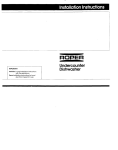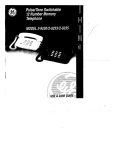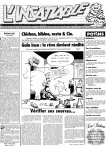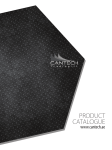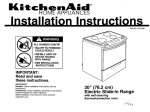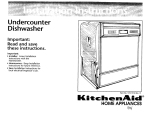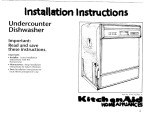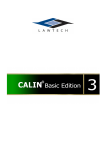Download Whirlpool 3395339 Specifications
Transcript
‘ted Drye lnst ‘IUCbI tiol stud c %s Part No. 3395339 Before you start... Check location where dryers will be used. Proper installation is your responsibility The dryer must not be installed or stored in an area where it will be exposed to water and/or weather. Make sure you have everything necessary for correct installation. Protection from weather: Proper operation requires temperatures above 45°F (7.2”C). The wiring diagram is located inside the control panel and access panels. Each of the dryers is equipped with a timer, selector switches and indicator lights. The timers are set to provide 45 minutes (4 pins) of drying time when activated by the coin slide. Timer cams for 30-minute (6 pins) and 60minute (3 pins) drying timers are supplied with the unit in the parts bag. See Pages 7 and 8 for timer cam changing instructions. l/S-inch-NPT plugged tapping is required. See “Gas supply requirements,” Page 3. The coin-slide mechanisms, control panel lock and key, coin box and coin box locks and keys are not included and are available from usual industry sources, Fire Hazard For your safety, the information in this manual must be followed to minimize the risk of fire or explosion or to prevent property damage, personal injury or loss of life. - Do Not store or use gasoline or other flammable vapors and liquids in the vicinity of this or any other appliance. - WHAT TO DO IF YOU SMELL GAS: l Do Not try to light any appliance. l Do Not touch any electrical switch; Do Not use any phone in your building. l Clear the room, building or area of all occupants. l Immediately call your gas supplier from a neighbor’s phone. Follow the gas supplier’s instructions. - If you cannot reach your gas supplier, call the fire department. - Never install dryer up against draperies or curtains or on carpet. - Keep any and all items from falling or collecting behind the dryer. Installation and service must be performed by a qualified installer, service agency or the gas supplier. Post this warning in a prominent location. It is recommended that the operator post, in a prominent location, instructions for the customer’s use in the event that the customer smells gas. This information should be obtained from your local gas supplier. Page 2 Important: Observe all governing codes and ordinances. -4 Dryers may be exhausted from bottom, rear, left or right side. See “Exhaust requirements,” Pages 5 - 6. ded electrical outlet is -required. See “Electrical requirements,” Page 4. Support: The floor must be able to support the total weight of 3 15 pounds per unit. Level floor: Maximum floor slope under dryers - 1 inch. Fire Hazard If you install dryers in a garage, carport, or areas near vehicles where fumes from gasoline or other vapors may be present, the vapors may be heavier than air and remain near the floor. Place dryers a minimum of 18 inches above floor. Check with your building inspector regarding requirements for this installation. Failure to follow these instructions could result in a fire or explosion. l Location must be large enough to fully open dryer doors. See Page 7 for recessed area requirements and product dimensions. Electrical Shock Hazard It is the customer’s responsibility: l To contact a licensed electrician. . To have dryers installed according to all national and local codes and ordinances. Failure to do so could result in a fire, electrical shock or other personal injury. Personal Injury Hazard More than one person is required to lift, tilt, or move the dryers because of their weight and size. Failure to follow these instructions may result in personal injury. Tools needed for installation: adjustable wrench utility knife Phillips screwdriver flat-blade screwdriver A n This installation must conform with American National Standard, National Fuel Gas Code ANSI 2223. llatest edition”, and all local codes and ordinances. level pliers duct tape Parts supplied for hstallation: 2 slide protectors 2 slide extensions 2 bolt and washer assemblies 8 screws 2,30-minute cams 2,60-minute cams 4,3/4” wood screws Parts owner must supply: 1 control panel lock and key 2 coin vaults and keys (E.S.D. vault must have projecting lock.) 2 coin-slide mechanisms (vertical 8) Parts may be ordered from Greenwald Industries, Inc. or Equipment Systems and Devices, l Greenwald Industries, Inc. 1340 Metropolitan Avenue Brooklyn, NY 11237 telephone (7 18) 82 l-9000 or toll free (800) 22 l-0982 fax no. (718) 417-7412 l Equipment Systems and Devices, Inc. 270 New Jersey Dr. Fort Washington, PA 19034 telephone (2 15) 628-0860 or toll free (800) 523-1510 fax no. (2 15) 643-4623 Inc. Gas supply reauirements Fire Hazard These dryers must be connected to a regulated gas supply. Failure to do so could result in highpressure gas release, resulting in a fire or explosion. l Have L.P. gas checked by a qualified person before installing the dryer. The L.P. gas supply must not exceed a pressure of 13” water column. l New flexible tubing should be used. Reusing old, flexible tubing might result in possible leaks or fire hazard. Failure to follow these instructions could result in fire or explosion. l CODES G n The supply line shall be equipped with a shutoff valve. This valve should be located in the same room as the dryers and should be in a location that allows ease of opening and closing. Do Not block access to shutoff valve. C n Check that dryers are equipped with the correct burner for the particular type of gas used. Burner information will be found on the rating plate in door well of the appliance. If this information does not agree with the type of gas available, see your dealer. D a OBSERVE ALL GOVERNING AND ORDINANCES. B n The desian of this drver has been certified bv the American Gas Association for use at altitudes up to 10,000 feet above sea level at the B.T.U. rating indicated on the model/serial plate. Burner input adjustments are not required when the dryer is operated up to this elevation. When installed above 10,000 feet, a four percent (4%) reduction of the burner B.T.U. rating shown on the model/serial plate is required for each 1,000 foot increase in elevation. For assistance when converting to other gas types and/or installing above 10,000 feet elevation, contact your local service company. F H If local codes and ordinances permit, it is recommended that new flexible metal tubing, design-certified by the American Gas Association, be used for connecting the dryers to the gas supply line. (The gas feed pipe, which extends through the lower rear of each dryer, is provided with 3/8inch male pipe thread.) n These dryers are shipped for use with NATURAL GAS. They are certified by the American Gas Association for manufactured, mixed and L.P. (propane and butane) gases with appropriate conversion. No attempt shall be made to convert the appliance from the gas specified on the rating plate for use with a different gas without consulting the serving gas supplier. Conversion must be done by a qualified service technician. Gas conversion kit part numbers are listed on the gas valve burner base. E n Provide a rigid gas supply line of l/2-inch IPS pipe to the dryer’s location. If the total length of the supply line is more than 20 feet, larger pipe will be needed. For L.P. gas usage, 3/8-inch, approved copper tubing may be used. Pipe-joint compounds suitable for use with L.P. gas should be used. main gas supply line, a combination of fittings must be used to obtain an in-line connection to the dryers. I n Make sure lower edges, back and sides of the cabinet are free of obstructions to permit adequate clearance of air openings for combustion air. See “Recessed area and closet installation instructions” for minimum spacing requirements. J n For ease of installation, operating and servicing (if ever needed), adequate space should be provided around the dryers. K n A l/8-inch, NPT plugged tapping, accessible for test gauge connection, must be installed immediately upstream of the gas supply connector to the dryers. The dryers and their individual shutoff valves must be disconnected from the gas supply piping system during any pressure testing of that system at test pressures in excess of l/2 psig (3.4 kPa). The dryers must be isolated from the gas supply piping system by closing their individual manual shutoff valves during any pressure testing of the gas supply piping system at test pressures equal to or less than l/2 psig (3.4 kPa). Page 3 Electrical requirements l/0” P (?.2 mm) pltre Plug checking inlet gas pressure) l/2” (12.7 mm) gas SUPPLY line (black iron pipe) t / flexible connector (use A.G.A. desi ncerti 3ied connector) \ L W If the dryers are installed in a confined area such as a bathroom or closet, they must be exhausted to the outside and provision made for enough air for combustion and ventilation. (Check governing codes and ordinances. Also refer to the section of this instruction covering “Recessed and closet installations.“) Electrical Shock Hazard Electrical ground is required on this appliance. l Do Not ground to a gas pipe. l Do Not modify the power supply cord plugs. If plugs will not fit the outlet, have a proper outlet installed by a qualified electrician. l Do Not have a fuse in the neutral or grounding circuit. A fuse in the neutral or grounding circuit could result in an electrical shock. l Do Not use an extension cord with this appliance. l Check with a qualified electrician if you are in doubt as to whether the appliance is properly grounded. Failure to follow these instructions could result in serious injury or death. l If codes permit and a separate grounding wire is used, it is recommended that a qualified electrician determine that the grounding path is adequate. OBSERVE ALL GOVERNING CODES AND ORDINANCES. A 120-volt, 60-Hz, AC-only, 1.5 or 20-ampere fused electrical supply is required. Time-delay fuse or circuit breaker is recommended. It is recommended that a separate circuit serving only these appliances be provided. Page 4 Kz+;rdmended grounding For your personal safety, these dryers must be grounded. Each dryer is equipped with a power supply cord having a 3-prong grounding plug. To minimize shock hazard, the cords must be plugged into mating 3-prong grounding-type wall receptacles, grounded in accordance with National Electrical Code ANWNFPA 70 - latest edition”‘, and all local codes and ordinances. If a mating wall receptacle is not available, it is the personal responsibility and obligation of the customer to have a properly grounded, 3-prong wall receptacle installed by a qualified technician. See Figure 1. 800 00 8 I cord Figure 1 Copies of the standards listed above may be obtained from: *American Gas Association 11515 Wilson Boulevard Arlington, Virginia 22209 ** National Fire Protection Batterymarch Park Quincy, Massachusetts Association Exhaust requirements Fire/Health Hazard Do Not use non-metal, flexible duct. l Do Not use metal duct smaller than four inches in diameter. l Do Not use exhaust hoods with metal latches. l Check that exhaust system is not longer than specified. Exhaust system longer than specified will: - Accumulate lint. - Shorten the life of the dryer. - Reduce the performance, resulting in longer drying times and increased energy usage. Failure to follow specifications may result in a fire. l Do Not exhaust dryers into a chimney, furnace cold air duct, attic or crawl space, or any other duct used for venting. 9 Clean the exhaust system every other year. l Do Not install flexible duct in enclosed walls, ceilings or floors. Accumulated lint could result in a fire or cause moisture damage. . Exhaust dryers outside to prevent exposure to substances in gas fuels and combustion which may be harmful to your health. The moisture and lint indoors may cause: - FIRE HAZARD from lint collected in dryer. - Moisture damage to woodwork, furniture, paint, wallpaper, carpet, etc. - Housecleaning problems and possible health problems. Failure to follow these instructions could result in fire damage or personal injury. Metal flexible duct must be fully extended and supported when the dryers are in final position. DO NOT KINK OR CRUSH THE DUCT. The metal flexible duct must be completely open to allow adequate exhaust air to flow. l Allow as much room as possible when using elbows or making turns. Bend duct gradually to avoid kinking. Remove excess flexible duct to avoid sagging and kinking that may cause reduced airflow. The external exhaust ducts can be routed straight out the back of the dryers. Kits are available to convert the external exhaust duct to be routed right, left or through the bottom. See Page 6. Product dimensions and recessed area requirements are given on Page 7. Side or bottom exhaust: The maximum length of the exhaust system if dryer is exhausted out the side or bottom is 16 feet with two external elbows and hood. Rear exhaust: The maximum length of the exhaust system depends on the type of duct, the number of elbows and the type of exhaust hood. The maximum length for both rigid and flexible duct is shown in the chart. This chart applies exhausted units. I MAXIMUM 0 1 2 MAXIMUM Exhaust materials supplied. If dryers are installed in a confined area such as a bedroom, bathroom or closet, they must be exhausted to the outside and provision must be made for enough air for combustion and ventilation. (Check governing codes and ordinances. Also refer to the “Recessed area and closet installation instructions,” Page 7.) An exhaust hood should cap the exhaust duct to prevent exhausted air from returning into the dryers. The outlet hood must be at least 12 inches from the ground or any object that may be in the path of the exhaust. Four-inch outlet hood is preferred. However, a 2- l/2-inch outlet exhaust hood may be used. (A 2-l/2-inch outlet creates greater back pressure than other hoods.) A main exhaust duct can be used for exhausting a group of dryers. Main exhaust duct should be sized to remove 200 CFM of air per dryer. Large-capacity lint screens of proper design may be used in the main exhaust duct if checked and cleaned frequently. The room where the dryers are located should have make-up air equal to or greater than the CFM of all the dryers in the room. Use duct tape to seal all joints. are not 0 1 2 only to individually EXHAUST HOOD TYPE LENGTH OF 4-INCH DIAMETER RIGID METAL DUCT 43 FT. 33 FT. 23 FI. 41 FT. 31 FT. 21 FT. LENGTH OF I-INCH 30 FT. 24 FT. 16 FT. 36 FT. 26 FT. 16 FT. DIAMETER FLEXIBLE METAL DUCT 29 FT. 23 FT. 15 FT. 24 FT. 18 FT. 10 FT. For exhaust systems not covered by the exhaust length chart, see WhirlDool Service Manual, “Exhausting Whirlpool Dryers,” Part No. 603197, available from your Whirlpool parts distributor. Four-inch metal exhaust duct is required. Plan installation to use the fewest number of elbows and turns. , Service check: The back pressure in any exhaust system used must not exceed 0.6 inches of water column measured with an inclined manometer at the point that the exhaust system connects to the dryers. Back-draft damper kits (Part No. 3391910) are available from your Whirlpool dealer and should be installed in each dryer’s exhaust duct to prevent exhausted air from returning into the dryers and to keep the exhaust balance within the main exhaust duct. Unobstructed air openings are required. Each exhaust duct should enter the main duct at an angle pointing in the direction of the airflow. Ducts entering from the opposite side should be staggered to reduce the exhausted air from interfering with the other ducts. The maximum angle of each duct entering the main duct should be no more than 30”. Page 5 Product Damage Keep air openings free of drycleaning fluid fumes. Fumes create acids which, when drawn through the dryer heating units, can damage dryers and loads being dried. L A clean-out cover should be located on the main exhaust duct for periodically cleaning the exhaust system. An exhaust hood should cap the outside end of the main duct to prevent exhausted air from returning to the dryers. If an exhaust hood cannot be used, the outside end of the main duct should have a sweep elbow directed downward. If the main duct travels vertically through the roof rather than through the wall, install 180” sweep elbow on the end of duct at least 2 feet above the highest part of the building. The opening wall or roof shall have a diameter l/2 inch larger than the exhaust duct diameter. The exhaust duct should be centered in the opening. Exhaust duct connection Electrical Shock Hazard Disconnect both power supply cords before making these changes. Failure to do so may result in electrical shock or personal injury. Determine which direction you need to attach the exhaust ducts to the dryers. Both dryers can be exhausted straight out the back or from the right or left side. The lower dryer can also be exhausted through the bottom. Next, determine the length of exhaust duct you will need to connect the dryers to exhaust hoods or the main exhaust. To connect exhaust duct straight out the back- exhaust hood or l-l wall RI+ 2 ft. min. 180 sweep Attach exhaust duct to each dryer duct. Then connect exhaust ducts to exhaust hoods or main exhaust. Use duct tape to seal all joints. highest point of main collector Do Not install screening of duct. Page 6 cap over end This dryer may be converted to be exhausted out the right or left side or through the bottom. To convert the dryer, one of the following kits MUST be used: Exhaust Kit No. 279818 (White) Exhaust Kit No. 279819 (Almond) Follow the instructions in the Kit to avoid operational and personal hazard. Recessed area and closet Installations Fire/Health Hazard Exhaust dryers to the outside to prevent exposure to substances in the gas fuels and combustion byproducts which may be harmful to your health. Failire to do so may result in a fire or health hazard. Closet view Side view Additional clearances for wall, door and floor moldings may be required. Additional space may be needed for exhaust elbow. I- 7” L This appliance may be installed recessed area. in a The installation spacing is the minimum allowable. Additional spacing should be considered for ease of installation, servicing and compliance with local codes and ordinances. If closet door is installed, the minimum unobstructed air openings in the top and bottom are required. Door must have two centered openings as illustrated. Both openings must provide a minimum of 72 square inches of unobstructed airflow as shown. Louvered doors with equivalent air openings are acceptable. Opening is minimum for closet door. Louvered door with equivalent air openings is acceptable. Companion appliance should be considered. Product Electrical Shock Hazard Disconnect both power supply cords from the electric power supply before making these changes. Change timing cams before completing electrical connection. Failure to follow these instructions may result in electrical shock or personal injury. Each dryer is equipped with a 45 minute timer cam that provides 45 minutes of drying time when activated by the coin slide. Front view spacing No other fuel-burning appliance be installed in the same closet. To change to a 30- or 60-minute timing cam You can install the 30-minute or 60minute timing cam (shipped with each dryer) as follows: may 1. Unlock control panel. Lift up and rotate out from cabinet. Control to cabinet. panel WIII STIIIDe attached dimensions Side view 2. Reach into control panel area. Use a Phillips screwdriver to loosen (but not remove) timer mounting bracket screw. Lift up to remove timer assembly and bracket from cabinet. FOR CLOSET INSTALLATIONS, TO PREVENT LARGE AMOUNTS OF LINT AND MOISTURE FROM ACCUMULATING, TO MAINTAIN DRYING EFFICIENCY, AND TO PREVENT EXPOSURE TO POSSIBLE HEALTH HAZARDS, DRYERS MUST BE EXHAUSTED OUTDOORS. r ratchet tooth + 4 0” approx. Additional clearances may be required for wall. door and floor moldings if external exhaust elbow is used. Rear view pJ llB/ Recessed 3. Turn the timing cam by hand until the ‘I/“-shaped notch lines up below the ratchet tooth. kttom exhaust front view Page 7 timyg ratchet Now start... cam a With dryers in laundry tooth area. 1 n Check that each leg is approximately 1 inch from base. line up notch to clear ratchet tooth. \ drive lug 2. Wipe the interior of the drums thoroughly with a damp cloth 3. Install coin vaults and locks (not supplied) into meter case openings. 4. Insert a narrow, flat-blade screwdriver under the timing cam near the clock shaft. Gently lift cam straight up and off shaft making sure that the “V-shaped notch clears the ratchet tooth. 5. Place new cam (hub side down) over clock shaft Line up flat side of shaft with flat side of cam hole. Check that drive lug is in place. 6. Turn cam until “V-shaped lines up with ratchet tooth. notch 4. Install control supplied). panel Open control panel and rest it on the bottom edge of the opening. Attach slide extension (with flange pointing down) to one of the coin-slide mechanisms, Insert the coin-slide mechanism through the opening to the left of the control panel. lock and key (not Electrical Shock Hazard Control panel must be closed and locked at all times. Failure to do so could result in serious injury or death. 7. Press cam down in place on motor shaft. Make sure that “V”-shaped notch clears the ratchet tooth, 7. Secure coin-slide mechanism from inside the control panel using the 3/l 6” bolt and washer supplied. Install coin box. 8. Reattach the timer bracket assembly; tighten the screws, 9. Repeat 10. 8 steps for other timer Close and lock the control n Repeat Steps 6 and 7 for the other coin-slide mechanism. Close control panel. panel. If you wish to change the 45minute dryer timing cams to either 30- or 60minute timing cams, see “To change to a 30- or 60-minute timing cam,” Pages 7 and 8. Complete all of the steps given in that section before going to Step 6. 9.. Electrical Shock Hazard Disconnect electrical power at the service panel (fuse box or circuit breaker box). Failure to do so could result in serious injury or death. Page 8 Insert top of wire guard into holes on each side of the coin-slide mechanism. Insert screws through hooked ends of guard and tighten. Repeat for other wire guard. 14 w Remove pipes. the red caps from the gas 800 00 8 0 16. Check levelness of dryers by placing a carpenter’s level on top of the dryers or collar, first side to side, then front to back. If dryer is not level, adjust the front legs up or down. Make the final check with the level. Plug power supply cords into grounded outlets. Turn on electrical power supply. 11. Connect gas supply to each dryer. Use pipe-joint compound resistant to the action of Natural and L.P. gas for gas connections. Floor Damage Slide dryers onto cardboard or hardboard before moving across floor. Failure to do so may result in damage to floor covering. Move unit to its permanent location. 12. Open the shutoff valves supply lines. in the gas Fire Hazard Do Not use an open flame to test for leaks from gas connections. Checking for leaks with a flame may result in a fire or explosion. 13. Use a brush and liquid detergent to test all gas connections for leaks. Bubbles around connections will indicate a leak. If a leak appears, shut off gas valve controls and adjust connections. Then check connections again. NEVER TEST FOR GAS LEAKS WITH A FLAME. Close the access panels. All connections must be wrenchtightened. 15. Turn one dryer on to remove air from the gas supply line. Using a full heat cycle (not the air cycle), let the dryer run for at least five minutes, If the burner does not ignite and you can feel no heat inside the dryer, shut off the dryer for five minutes. Check that all supply valve controls are in ‘ON” position and that the power supply cord is plugged in. Repeat the fiveminute test. 17 n TO exhaust the dryers, see “Exhaust requirements” and “Exhaust duct connection,” pages 5 and 6. Personal Injury Hazard To prevent tipping, tether bracket must be secured to wall studs or concrete wall. Failure to do so could result in personal injury. Tether bracket, located rear of the top dryer. at w Attach both ends of tether located at the rear of the top dryer to a secured 2x4. Page 9 77. IO. 7 7. 14. 16.7.9. Check to ma& Sure you have all Your tools. 7. 0. 77. correspond with steps. If dryers do not operate properly... Check the following 1. Electrical Move dryers to a new location... to be sure that: supply is connected. 2. Circuit breakers fuses blown. are not tripped Floor Damage Slide dryers onto cardboard or hardboard before moving across floor. Failure to do so may result in damage to floor covering. or 3. Doors are closed. 4. Timer has been actuated, 5. Controls are set in a running “ON” position. or 6. Gas shutoff valves are open on dryer and supply line. both l l l l l l l Shut off electric supply to dryers. Disconnect power supply cords. Tape securely to dryer. Shut off the gas supply valves in the gas supply line. Disconnect gas pipe and fittings from dryer and cap the gas supply line. Tape end of dryer gas pipes. Tape the drums to the front panel. Tape doors. Adjust leveling legs all the way in. Before installing dryers in a new location, check with your gas supplier or dealer to see that your dryer is equipped with the correct burner for the particular type of gas in your new building. Burner information may be found on the rating plate in the door well of the dryer. If you need assistance... The Whirlpool Consumer Assistance Center will answer any questions about operating or maintaining your dryers not covered in the Installation Instructions. The Whirlpool Consumer Assistance Center is open 24 hours a day, 7 days a week. Just dial l-(800) 253-l 301 - the call is free. When you call, you will need the dryer model number and serial number. Both numbers can be found on the serial/rating plate located in the door well behind the dryer door and on the front of the opening. Part No. 3395339 0 1994 Whirlpool Corporation Prepared by Whirlpool Corporation, Benton Harbor, Michigan 49022 Printed in USA












